“I only know two people who have climbed the route, and both of them refuse to come back. Now I know why.”
We’re taking a break in a shallow snow cave when Jason reveals this fun statistic. I just nod and break off another piece of frozen Clif Bar. Standing up from my makeshift snow seat, I stare across the valley at the ice line carving a long, white streak down the face of the mountain. I follow the cliff band back around to the saddle behind me in search of perspective. Are we closer to the climb or closer to the car?
The climb, I think, but not by much. I guess that’s preferable. I put on my pack, and the metal chime of my ice tools reminds me why I’m here. I feel guilty that I would rather be at home, and, in the first few steps away from the relative safety of the cave, I resolve to be happy…
Jason introduced me to the idea of climbing the Sphinx on our drive home from the Beartooths. The hike to and from Funeral for a Friend left him satisfied with our collective fitness level, and he was excited that he finally had a partner who seemed willing to walk for a while.
Named, appropriately, for its resemblance to the Egyptian monument, the Sphinx rises high above Ennis, Montana – roughly 75 miles southwest of Bozeman – and features three conspicuous ice lines on its north face. High altitude and abundant shade make for reliable early season routes, and Jason was pretty sure that the ample approach would yield some classic climbing.
We left Bozeman just after sunset on Tuesday night and slept on a tarp at the trailhead. My phone alarm woke us up at 2:30, and I enjoyed a hero’s breakfast of crackers, Craisins, and a double-sized Red Bull in the chilly morning darkness. Half an hour later, we were traveling down the trail under a canopy of blazing stars.
The approach to the route has two distinct parts: a five-mile trail hike to a pass beneath the Sphinx and a snowy slog from the saddle to the base of the climb. The trail, though icy from the start and snow-covered from the middle on, is well-traveled and fast. We took advantage of the easy terrain and, with boots strapped to packs, cruised to the saddle in running shoes. Once atop the ridge, we ducked into a grove of pines to escape the blustery wind, and there, amidst the blanketed trees, we got a drink and a snack and waited for the sun to rise.
I find a special satisfaction in moments such as this – the moments between definite periods, the indeterminate, the liminal.
Until the sun comes up, I am relieved of obligation. I am safe. I am free. Here, I can recognize the hours I have already spent hiking and disregard the hours I have left. I can remember the songs that passed through my head at specific points on the trail. I can reflect on the momentary sensations of joy and fear that we all experience in the wilderness – the noises and the sights; the missteps and the brief departures; the miles that passed in peaceful meditation and the yards that dragged in tedious effort. I think ahead to the climb. I imagine the way my hands will ring when my tools sink into the ice. I wonder if I’ll reach that magical state where the climbing feels effortless and right. I imagine the contentment and relief that will wash over me if we succeed. I wonder if I will accept defeat with honor or endure it in resentment. I imagine the panorama that awaits at the top. I wonder what time it will be when I see this grove again.
I imagine. I wonder.
I am angry at the sun when it finally erases my starry sanctuary; yet another liminal paradise is lost. With a rueful smile, I shoulder my pack and resume my journey.
The approach trail leaves the grove and follows a vague path up the western face. The mountain is roughly pyramidal, but the tiers on the north face restrict access to a small window five hundred feet above the saddle. If you’re too high on the western face, you’ll turn the corner onto an impassable cliff. If you’re not high enough, you’ll be looking at some exposed climbing to get back up to the right ledge system. Trouble is, it’s impossible to tell from the western face where you’ll need to be in half a mile. Jason and I settled on one of the lower weaknesses and bounded through the deep snow. We broke trail for half an hour before some faint footprints appeared one ledge above us. Could be worse. A tenuous climb up fifteen feet of snow and crumbling rock had us on the main highway.
For the next two hours, we took turns breaking through the virgin snow. Some stretches meant breathless high knees through deep powder. Some stretches required careful ice tool traverses across iron-hard crust. A hundred yards of either meant a shift change – fresh legs up front and time to recover in the back.
It was 9:30 when we reached the snow cave. By 11:00, we were trudging up the final powdery hill. Two other climbers, benefiting from our tracks, caught up to us a few hundred yards from the base of the climb, and their profuse thanks provided some welcome encouragement for the final push. The four of us reached the ice at 11:30.
Our route was an area classic called The Lowe Route. The crux first pitch, chandeliered and fragile, goes at a full WI 5, and we were not prepared to deal with the semi-detached ice pillar. The four of us soloed up an adjacent snow gully; exposed but easy climbing capped with one tricky move at the top got us to the next ledge. The second pitch began with a steep section of WI 4 before rolling over easy bulges for a full rope length. Eric, one of our new friends and a former Exum guide, repaid the trail-breaking favor by ropegunning the pitch for us.
The climbing was excellent.
The initial face proved strenuous and thrilling. New swings of each tool produced a shower of plates and chips, but the blue and plastic ice underneath was secure and trustworthy. With failing forearms and burning calves, I clawed up the first truly difficult pitch I’ve climbed this season.
Fifty feet of steep front-pointing finally leveled off to good stances and a well-needed rest. An easy twenty feet put us at the bottom of another vertical wall; I stemmed against the rock gully for a stylish M 0 variation and floated to the top. At the belay, I gave Jason some gear and watched him cruise up the WI 3 third pitch. He ran out of rope in the middle of a snowfield, and we simul-climbed forty feet to the next section of protectable ice.
I swung by him at the belay and enjoyed the final WI 3 pitch on the sharp end. One screw protected the top of the first ledge, and I ran out the remaining eighty feet to the summit snowfield. Contented and relieved, I relaxed in the warm sun and belayed Jason to the top. We stacked the ropes and repacked our gear and laughed about the climb behind us. Nothing but eight miles of downhill to go before the car, the gas station (Gatorade!), and warm beds…
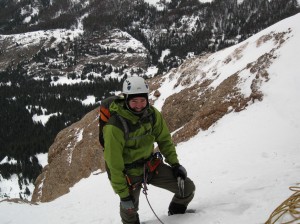
Still in good spirits at the first belay...
Enter misery – windy, snowy, face-burning, leg-cramping, cold, wet misery.
The descent route funnels down a backside gully. I struggle to make progress as the wind pushes me back uphill. Several times I unabashedly crumble to the ground to avoid the punishing spindrift. My jacket’s hood has been adjusted to accommodate my climbing helmet; my helmet is packed. My frozen gloves can’t find the toggle, so I have to hold my hood in place as I stumble, exhausted, down the hill.
When we reach the grove again, I nearly collapse. I rifle through my pack for crackers and water. Jason is in such a hurry to reach the car that he doesn’t stop at all. I’m jealous that he has even the energy for such a protest. Poetically, the sun disappears beneath the horizon while I sit, cold and helpless and alone, on the same log from which I watched it rise twelve hours prior. I imagine what it feels like to die. I wonder if I want that now.
I imagine. I wonder.
I retrieve the running shoes that I’ve been coveting for miles, yet I remain unable to put them on as my boot laces are frozen solid. I pry the laces out of the metal grommets with the pick of an ice tool and remove the merciless plastic shells. I attempt to pack up. I strap my boots to the pack; I reattach the tools. I take a last sip of water and throw everything else in the pack. Crampons back on top, and I’m out of here. Crampons… Crampons…? Crampons?! I scan my area hopelessly. I backtrack out of the grove and stare up at the desolate miles of thieving gully. Fuck that. Not even an option right now.
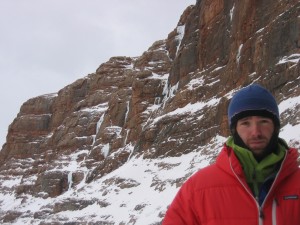
I've been happier.
I spend most of the two hour descent trail debating whether or not I’ll come back for a retrieval mission in the next few days. By the time I get home, I have myself convinced to go. Michelle has dinner ready when I finally drag myself into the apartment, and I find that I’m almost too tired to thank her. I tell her a little bit about the day. She graciously offers to return with me to search for the erstwhile crampons; I consider this.
I fall asleep amidst a storm of emotion: I am proud of the climb; I am thrilled to be in bed; I am depressed about the crampons; I am dreading the impending trip back to the top…
I am almost overjoyed when I wake up the next day. Three feet of fresh powder has fallen in Bozeman. I imagine the beautiful blanket of snow that has buried my now-irretrievable crampons in the mountains. I wonder if I should be this pleased about it.
I imagine. I wonder…
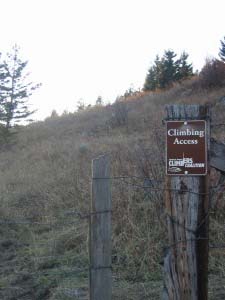
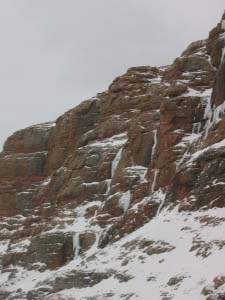
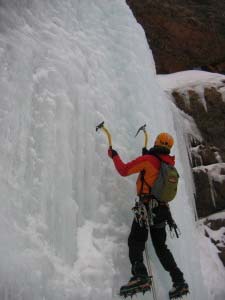


Miss you. Love your blog.